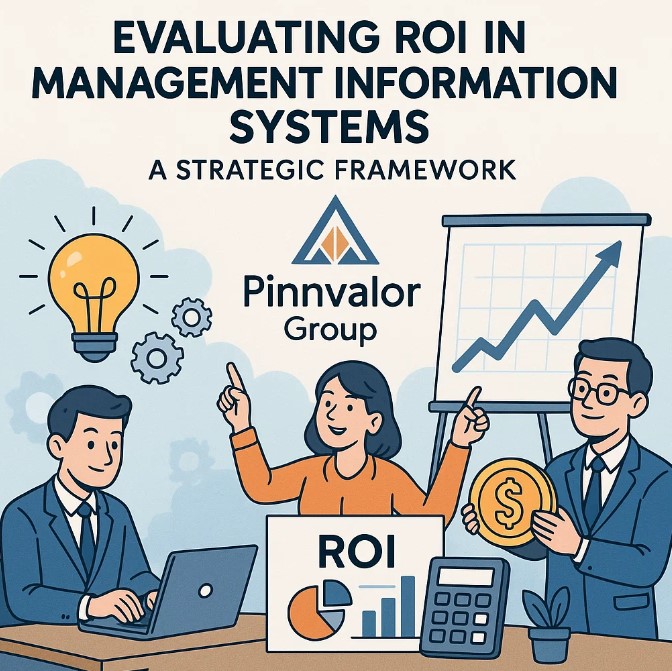
Evaluating ROI in Management Information Systems: A Strategic Framework
In an increasingly digital economy, Management Information Systems (MIS) serve as the backbone of data-driven decision-making and operational efficiency. However, while the strategic importance of MIS is widely acknowledged, evaluating its financial and organizational return on investment (ROI) remains a significant challenge for many enterprises.
This blog presents a structured and strategic framework for evaluating the ROI of MIS, balancing tangible financial metrics with intangible strategic outcomes.
Is your MIS driving measurable ROI, or are you missing out on its full strategic potential?
A powerful MIS does more than automate processes—it transforms data into decisions and technology into competitive advantage.
Understanding MIS and Its Strategic Role
Management Information Systems (MIS) integrate technology, people, and processes to collect, analyze, and deliver actionable information for decision-making. Their applications range from financial reporting to customer relationship management, supply chain coordination, and beyond.
While the operational benefits are clear, organizations must evaluate whether the investment in MIS translates into actual business value—a process that demands a broader strategic lens than traditional ROI assessments.
Why Traditional ROI Approaches Fall Short
Traditional ROI formulas—like:
ROI = (Net Benefit / Investment Cost) × 100
—focus primarily on short-term, quantifiable returns. However, MIS impacts are often:
- Long-term and strategic: such as improved decision-making
- Intangible: like enhanced employee morale or better organizational alignment
- Interconnected: affecting multiple business functions simultaneously
These characteristics necessitate a more nuanced, multidimensional framework for evaluation.
A Strategic Framework for Evaluating MIS ROI
1. Set Strategic Objectives Aligned with Business Goals
Before measuring ROI, define the strategic purpose of the MIS investment. Common objectives include:
- Enhancing customer experience
- Supporting data-driven decision-making
- Reducing operational inefficiencies
- Enabling organizational agility
Use the Balanced Scorecard approach to align MIS outcomes with financial, customer, internal process, and learning and growth perspectives.
2. Identify and Categorize Investment Costs
Break down costs into three main categories:
- Initial Investment: Hardware, software, licensing, implementation, consulting, and training
- Ongoing Costs: Maintenance, support, system upgrades, staff salaries
- Opportunity Costs: Time and resources diverted from other initiatives
3. Measure Tangible and Intangible Benefits
Tangible Benefits:
- Reduction in report generation time
- Labor cost savings from automation
- Increased sales from better market insights
- Lower inventory holding costs
Intangible Benefits:
- Improved strategic planning and forecasting
- Higher employee and customer satisfaction
- Stronger compliance and governance
- Increased organizational transparency

4. Use Multi-Dimensional Financial Metrics
Instead of relying solely on basic ROI, apply a mix of financial indicators:
| Metric | Purpose |
|---|---|
| Net Present Value (NPV) | Assesses profitability after discounting future benefits |
| Internal Rate of Return (IRR) | Shows the break-even growth rate of the investment |
| Payback Period | Measures how long it takes to recoup the initial investment |
| Benefit-Cost Ratio (BCR) | Compares the benefits to the costs in a single figure |
5. Evaluate Strategic Impact
Conduct a strategic impact analysis using these methods:
- SWOT Analysis: Examine how MIS strengths and opportunities can mitigate threats and weaknesses.
- Scenario Planning: Explore how MIS performance shifts under different market or organizational conditions.
- Value Chain Analysis: Map MIS contributions across operations, from inbound logistics to after-sales support.
6. Implement Feedback Loops and Continuous Assessment
ROI evaluation shouldn’t end after implementation. Establish ongoing performance metrics and KPIs:
- System uptime and reliability
- User adoption and satisfaction rates
- Decision-making cycle times
- Data accuracy and reporting quality
Case Snapshot: MIS in a Logistics Firm
A mid-sized logistics company implemented an MIS to unify its fleet tracking, inventory, and billing systems. Strategic objectives included faster delivery processing, better customer service, and reduced overhead.
Investment: $750,000 over two years
Measured Benefits (Annual):
- Labor cost savings: $180,000
- Reduced delivery errors: $60,000
- Faster billing cycle improved cash flow: $100,000
- Customer satisfaction index increased by 20%
Result:
- Payback period: 2.6 years
- NPV over 5 years: $420,000
- IRR: 18%
- Strategic benefit: Positioned for rapid expansion with scalable infrastructure
Best Practices for Strategic ROI Evaluation
- Engage Cross-Functional Teams: Finance, IT, operations, and end-users must collaborate.
- Document Assumptions: Transparency in assumptions enhances credibility.
- Benchmark Externally: Compare with similar MIS implementations in the industry.
- Balance Short-Term and Long-Term Gains: Don’t sacrifice strategic potential for quick wins.
Conclusion
Evaluating the ROI of MIS requires more than spreadsheets and profit margins. It demands a strategic mindset that appreciates both quantifiable gains and intangible, long-term value. By adopting a structured, multi-dimensional framework, organizations can ensure that their MIS investments not only pay off financially but also drive sustained competitive advantage.
